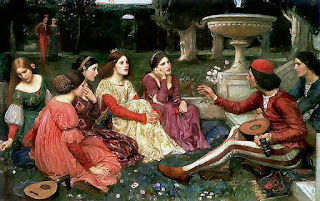Whan Adam delf, and Eve span,
Wo was thanne a gentilman?
This was part of a sermon allegedly delivered in Blackheath the night before that group of peasants descended upon London during the Peasants' Revolt of 1381. Although the catalyst for the Revolt may have been a poll tax, resentments against the upper classes were always ready to boil over.
Flemings were not generally a large part of the countryside peasant population.
Flemings were, however, mentioned specifically in one account of the Revolt, and it has two curious features. The account in MS Cotton Julius B.II. ends with the lines:
...and many fflemynges lost here heedes at that tyme, and namely they that koude nat say 'breede and chese", but "case en brode".
It was curious that Flemings were mentioned specifically. Also, contemporary references to language in the 14th century are extremely rare, so why distinguish these foreigners with a reference to their tendency to idiomatically express "bread and cheese" as "case and brode." (Modern German for cheese is still "Käse" and for bread is "Brot" with a long ō sound.)
One of the targets for destruction was the "stews" or brothels of Southwark, just south of London across the Thames. It was an area well known for prostitution, and that particular profession at that time was dominated by Flemings. One particular Fleming-run brothel was invaded and destroyed by the mob, but it was owned by the mayor of London, William Walworth, so the destruction may have been aimed at him as a representative of the upper classes—in the spirit of the first quotation above—rather than the foreigners specifically.
But it seems likely that the Revolt, as often happens, "broadened its scope" as the angry mob let its anger focus on several different targets, whether they were a rational reason for the start of the Revolt or not. Xenophobia has been a part of human culture since the beginning of human societies, I would wager, and 14th century England was no different. Distinguishing foreigners by their idiomatic expressions of everyday objects like "bread and cheese" is petty, racist, and perfectly believable.
There was, in fact, other acts of violence against Flemings on the same day of the Revolt, 13 June, as well as the following day, that are not mentioned in any chronicle of the Revolt itself, but come from the law courts. There is a pardon for a man from Holborn who killed seven Flemings just north of London, at Clerkenwell, on 13 June. On 14 June, 35 Flemings were dragged from St. Martin Vintry church and beheaded. The official London records confirm that rebels dragged Flemings from houses and churches in Vintry ward, resulting in 40 decapitated bodies in the street.
Hostility against Flemings continued in the week after the Revolt, and at various locations not connected to the Revolt.
Chaucer even refers to the attacks on the Flemings. He was a likely witness to the event, since he was living in an apartment at one of the city gates at the time. In the Nun's Priest's Tale he refers to the shrill voices of the rebels as they killed Flemings.
Why the Peasants' Revolt turned into an opportunity to show extreme prejudice against Flemings particularly is unclear. Flemings would not have been the only foreigners in London, nor did they represent the upper classes, which was one of the targets of the Revolt. It may have been a case of "foreigners taking our jobs." Coastal flooding several years earlier in the Low Countries had caused many weavers from Flanders to seek a living elsewhere, and there was an influx of Flemish weavers into the English textile scene in the 1370s that caused hostility from the English weavers. This was not a new development, however:
Edward III had encouraged Flemish weavers in the 1330s to settle in England. Of course his wife,
Queen Philippa, was from the Low Countries, and his suggestion may have been at her suggestion.
It might also be that they wanted to help Fleming peasants who had held their own uprising a few years earlier, which we will look at next.



















